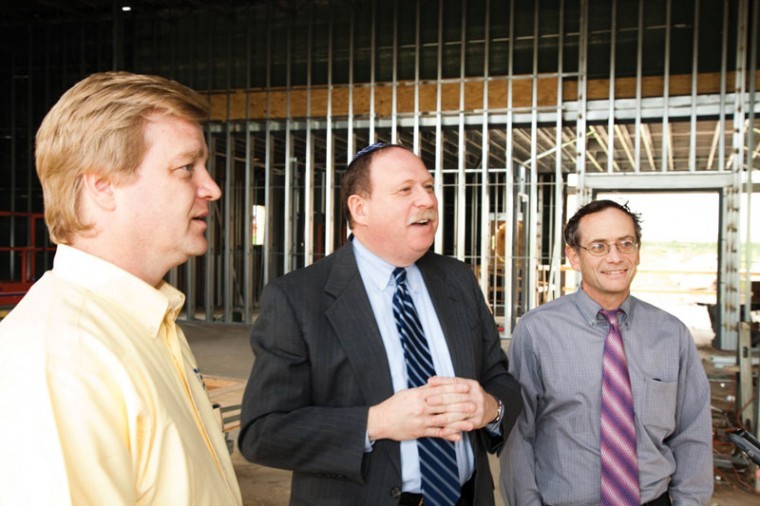The greening of the shul
Published April 21, 2011
It’s a staple of synagogue life. Meeting rooms, lobbies, even individual bricks can be dedicated in memory of a loved one or in honor of a family that has contributed to the congregation. Nusach Hari B’nai Zion is no exception to the rule. But as shul president Bob Kaiser points out, NHBZ’s new building will also offer a decidedly 21st century way to recognize the deserving.
Solar panels.
“There’s going to be a monitor in the lobby that will track each panel on the roof,” he said.
People can adopt a panel and name it. They can see how many trees they’ve saved.”
The readout will also tell congregants how many tons of carbon “their” panel kept out of the atmosphere.
“We don’t intend to just build the building, announce it with fanfare and then have people forget what it is we’re doing,” Kaiser said.
What they are doing is constructing a synagogue rife with “green” features. The Orthodox shul broke ground last summer on the two-story structure, which is slated to replace their old University City location on Olive Blvd., this June. The approximately 13,000-square-foot edifice at Old Bonhomme and Price roads will be the first shul in the City of Olivette.
But it will be groundbreaking in more ways than that. For starters, it will be set pretty deep in the ground. The lower floor is below the land’s grade on two sides reducing the need for climate control and boosting energy efficiency.
The earth is a great insulator,” Kaiser said. “If you’ve ever been in a cave, it’s the same temperature 365 days a year.”
Not that heating bills will create much worry. In fact, NHBZ is hoping to hardly have any. There is a backup furnace, but it kicks in only if the outside temperature falls well into the single digits. Otherwise, heating will be provided by 30 geothermal wells drilled 200 feet below the Earth’s surface. Circulating liquid extracts warmth from deep in the soil while a similar method cools the building in the summer.
“When you get 18 feet below the ground, it’s 58 degrees year-round,” said Jason Parker, project manager at the site for Certified Solar Solutions. “That’s relatively warm in the wintertime.”
Parker’s company is handling the solar panels for NHBZ. Together, 65 of them are expected to generate nearly 15 kilowatts of energy, perhaps enough to run the entire building. If that’s the case, the synagogue may even be able to sell energy back to the utility gaining a credit on their bill.
“We’ll have two meters with Ameren,” said Kaiser, “one going out and one coming in. We send our kilowatts to them and when we need them, we pipe them back in.”
Windows will be computer controlled so that they cannot be opened or closed at the whim of human occupants, another feature that will curb energy usage.
Unnecessarily keeping the entire building climate controlled is one more wasteful habit the congregation will avoid.
“The cooling and heating systems are zoned so the areas that are not being used will just be kept on standby,” Parker said. “We have eight geothermal heating and cooling units so it’s possible to micro control exactly which parts of the building are receiving heat.”
The layout of the structure itself aims to make that task easier as well. Items that will be used during the week, such as administrative functions, child care operations, the teen lounge and the rabbi’s office will be grouped together on the lower floor while the sanctuary upstairs will be kept unheated when not in use for services.
Kaiser said that while the building, which uses recycled construction materials where possible, will incorporate many green features, it will not be it will not be a Leadership in Energy and Environmental Design (LEED) structure. He said LEED-certification would not have been realistic given the requirements for extra windows to create more natural light.
All told, while some of the building’s attributes may be pricier on the front end, the facility, expected to cost $2.1 to $2.5 million, will see a monetary benefit as time goes on.
“For the first five or six or seven years we’ll be paying a little bit more,” he said, “but you start to hit that curve and all of the sudden you find that you’ve paid off your system and you don’t have an Ameren bill.”
NHBZ’s Rabbi Ze’ev Smason said that aside from the lowered utility bills there are deeper reasons for the building’s design as well.
“It’s a fulfillment of a sacred pact, really a sacred obligation,” he said. “There are many sources found in the Torah that indicate that we should be a good steward of the environment and the world that God has given us and that we have to save not only for our own benefit but we have to treat the world as though it were ours. By being as environmentally conscious as possible, we’re fulfilling that dictum.”
He also said the structure’s benefits might have a practical lesson for those who worship there.
“I think there is tremendous potential for carryover value for our congregation by being green and environmentally friendly in the building itself,” he said. “You can’t help but notice it, so with proper instruction and reminders it will show people that they should be environmentally conscious in their own lives.”
And that goes back to those adopted solar panels.
“The idea is that we want people to understand that this is not just something the synagogue did but it’s something they can actively participate in on a daily basis,” Kaiser said. “We expect it to be a constant reminder of our ongoing obligation.”















